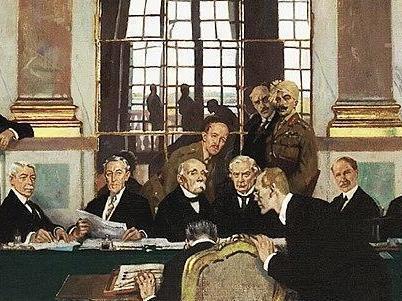Treaty of Versailles at 100: Path to peace or road to war?
The agreement is credited with formally bringing an end to the First World War, but its legacy is far more complex, writes Jon Stone


Your support helps us to tell the story
From reproductive rights to climate change to Big Tech, The Independent is on the ground when the story is developing. Whether it's investigating the financials of Elon Musk's pro-Trump PAC or producing our latest documentary, 'The A Word', which shines a light on the American women fighting for reproductive rights, we know how important it is to parse out the facts from the messaging.
At such a critical moment in US history, we need reporters on the ground. Your donation allows us to keep sending journalists to speak to both sides of the story.
The Independent is trusted by Americans across the entire political spectrum. And unlike many other quality news outlets, we choose not to lock Americans out of our reporting and analysis with paywalls. We believe quality journalism should be available to everyone, paid for by those who can afford it.
Your support makes all the difference.The first thing anyone arriving in Arras sees as they leave the train station is an angel-winged war memorial. Its message, carved in stone letters legible from the concourse, is starker than that on most monuments of its kind: “Arras a ses enfants morts pour la défense du droit” – or roughly, “Arras has her children dead for the defence of right”. The northern French city was just six miles from the frontline in the First World War, and was largely reduced to rubble.
The last five years have seen a run of centenaries related to the First World War: from the assassination of Franz Ferdinand that sparked the conflict, through its most bloody battles, and the armistice agreement signed in November 1918. Most of these anniversaries have been marked by solemn remembrance of the horrors of that war. But the signing of the Treaty of Versailles – which today on 28 June 2019 turns 100 years old – has a more complex legacy.
The treaty’s signatories are not putting on a grand show to mark the day: the states most deeply involved, France and Germany, now settle their differences at the European Council, and would rather put that part of their history behind them. But Arras is marking the date’s passing with an exhibition, organised by the Palace of Versailles itself but housed in the city’s fine art museum.
“Arras was a martyr city,” says its mayor Frédéric Leturque. “It was almost completely destroyed during the First World War. The cathedral and Saint Vaast abbey, which now houses the fine art museum where the exhibition was held, were reduced to ashes. This catastrophe disturbed the whole world; part of the amount of war reparations established by the Treaty of Versailles was used for the reconstruction of the town.”
Few international agreements are household names, but a century after its signing, the treaty – in which the allied powers imposed harsh terms on a defeated Germany – still looms large in the popular consciousness. Schoolchildren in countries across the world are taught that the 1919 agreement formally brought an end to the First World War, and played a big role in causing the second through the imposition of war reparations, the annexation of territory, and unenforceable but humiliating disarmament.
It is common for the Treaty of Versailles to be invoked today in arguments about modern foreign policy, as a warning from history: in March this year Nigel Farage raised eyebrows when he compared the treaty to the Brexit withdrawal agreement, suggesting the deal was too harsh and would entrench a lingering bitterness, or worse. Foreign policy commentators have also compared Donald Trump’s withdrawal from the Iran nuclear deal to the 1919 accord – suggesting the president’s aggressive approach risks escalation. By contrast, when people want the terms of an agreement to be tougher, they usually invoke the 1938 Munich agreement and appeasement – as Dick Cheney did of the Iran deal in 2016. There is a world war reference for everything, it seems.
At the time of its signing, the treaty was immediately controversial: in his bestselling 1919 book The Economic Consequences of the Peace, the economist John Maynard Keynes – who would go on to shape the aftermath of the Second World War – sketched a picture of a document drawn up by a conference of fools.
“Paris was a nightmare, and everyone there was morbid,” he wrote of the peace summit that drafted the accord. “A sense of impending catastrophe overhung the frivolous scene: the futility and smallness of man before the great events confronting him, the mingled significance and unreality of the decisions – levity, blindness, insolence, confused cries from without. All the elements of ancient tragedy were there.”
A painting by the British government’s war artist William Orpen, who was commissioned by the Imperial War Museum to capture the signing of the treaty, shows the signatories dwarfed into insignificance by the vast setting of Versailles’ hall of mirrors. Orpen, an Irishman who had spent the last years painting piles of dead bodies up close on the western front, intensely disliked the conference and its attendees – railing at their lack of respect for the suffering the war had caused. In his painting of the signing ceremony, which is reproduced at the Arras exhibition, US president Woodrow Wilson is depicted barely glancing up from his newspaper, disinterested in the whole affair. The US senate would later refuse to ratify the treaty.
But the signing was not Orpen’s most withering, nor controversial painting from the Paris conference: for his last canvas from Versailles he spent nine months painstakingly detailing senior politicians and soldiers in the palace’s Hall of Peace, before painting over them in disgust and covering their images with a depiction of a union flag-draped coffin, guarded by two emaciated, shell-shocked, semi-nude British soldiers. He later painted out the soldiers.
“I couldn’t go on,” he explained of the decision to paint over the original composition in 1923. “It seemed so unimportant somehow beside the reality as I had seen it and felt it when I was working with the armies.” The Imperial War Museum refused to accept the painting at the time, arguing it was not what had been commissioned. But despite being reviled by art critics for its subject matter and lack of technical prowess, it was a smash hit with the public when it was exhibited back in London.
The treaty that the conference produced was drawn up in the understandable but unhelpful sense of righteous grievance still on display in Arras: that of the “martyr city”, whose children were dead in the defence of liberty. But despite the document’s humiliating content, it lacked an enforcement mechanism, which proved a bitter combination – later exploited by the Nazis in the following decades. But though historians tend to agree that Versailles was a bad treaty, the question of whether it really put the world on the inevitable road to war from the moment it was signed is a more open one.
“I think the story is more complicated than that,” argues Professor Margaret MacMillan of the University of Toronto, in a lecture at the Museum of London in the run-up to the anniversary. She suggests it might be somewhat unfair to “blame those in the past for not knowing what is going to happen”.
She adds: “There are 20 years between 1919 and 1939, and many decisions have been made and unmade. I think we need to respect those 20 years and not simply see them as an interlude between one war and the other.
“I think it’s fair to say that the Treaty of Versailles helped to create some of the conditions of the Second World War, but I think it’s possible to argue that Europe had choices before it, and needn’t have gone down the road to war.”
Indeed, the exhibition in Arras is constructed in such a way as to remind visitors that the Treaty of Versailles was not unique in failing to prevent another European civil war. The chronology does not start at the Paris conference – nor even in the First World War, but 48 years before it, in 1871. The Hall of Mirrors in the Palace of Versailles was then used as the location of the proclamation of the German Empire, in the seat of the defeated and humiliated Second French Empire, at the end of the Franco-Prussian War. Fast forward to 1919, and French prime minister Georges Clémenceau’s choice of location for the signing was conscious, a deliberate tit-for-tat: we’re back here again, but this time, we’re in charge. Europe’s inability to build a sustainable peace that would prevent war was not new: the only thing that was new was the ability to kill millions of people with industrialised warfare.
The symbolic tit-for-tat might have continued: Hitler wished to use Versailles as the location for his ultimate treaty with the defeated allied powers, should he have won the Second World War. “The ceremony of the Treaty of Versailles,” Nazi propaganda minister Joseph Goebbels wrote in his diary, “should serve us as a model”. The historical exception was not Versailles, but what happened after the Second World War.
“I think we need to ask ourselves why we had a lasting peace after 1945, and are we any better at making peace today?” Professor MacMillan says. “I suspect the answer to the second question will be: no we’re not.”
Join our commenting forum
Join thought-provoking conversations, follow other Independent readers and see their replies
Comments